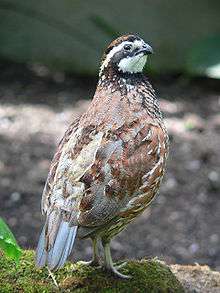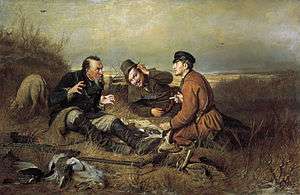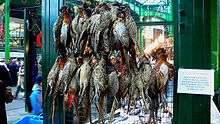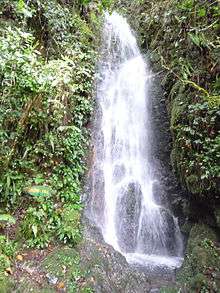Game (hunting)
.jpg)
Game or quarry is any animal hunted for sport or for food.
The type and range of animals hunted for food varies in different parts of the world. This is influenced by climate, animal diversity, local taste and locally accepted views about what can or cannot be legitimately hunted. Sometimes a distinction is also made between varieties and species of a particular animal, such as wild turkey and domestic turkey. Fish caught for sport are referred to as game fish. The flesh of the animal, when butchered for consumption is often described as having a "gamey" flavour. This difference in taste can be attributed to the wild diet of the animal, which usually results in a lower fat content compared to domestic farm raised animals. The term game arises in medieval hunting terminology by the late 13th century and is particular to English, from the generic meaning of Old English gamen (Germanic *gamanan) "joy, amusement, sport, merriment". Quarry in the generic meaning is early modern (first recorded 1610), in the more specific sense "bird targeted in falconry" late 14th and 15th centuries as quirre "entrails of deer placed on the hide and given to the hunting-dogs as a reward", from Old French cuiriee "spoil, quarry" (ultimately Latin corium "hide"), but influenced by corée "viscera, entrails" (Late Latin *corata "entrails", from cor "heart").
In some countries, game is classified, including legal classification with respect to licences required, as either "small game" or "large game". Small game includes small animals, such as rabbits, pheasants, geese or ducks. A single small game licence may cover all small game species and be subject to yearly bag limits. Large game includes animals like deer and bear and are often subject to individual licensing where a separate licence is required for each individual animal taken (tags).
Big game is a term sometimes used interchangeably with large game although in other contexts it refers to large, typically African, mammals (specifically "big five game" or "dangerous game") which are hunted mainly for trophies in safaris.
By region
Africa
In some parts of Africa, wild animals hunted for their meat are called bushmeat; see that article for more detailed information on how this operates within the economy (for personal consumption and for money) and the law (including overexploitation and illegal imports). Animals hunted for bushmeat include, but are not limited to:
- Various species of antelope, including duikers
- Various species of primates like mandrills or gorillas
- Rodents like porcupines or cane rats
Some of these animals are endangered or otherwise protected, and thus it is illegal to hunt them.
In Africa, animals hunted for their pelts or ivory are sometimes referred to as the big game.
Also see the legal definition of game in Swaziland.[1]
South Africa
South Africa has 62 species of gamebirds, including guineafowl, francolin, partridge, quail, sandgrouse, duck, geese, snipe, bustard and korhaan. Some of these species are no longer hunted, and of the 44 indigenous gamebirds that can potentially be utilised in South Africa, only three, namely the yellow-throated sandgrouse, Delegorgue's pigeon and the African pygmy goose warrant special protection. Of the remaining 41 species, 24 have shown an increase in numbers and distribution range in the last 25 years or so. The status of 14 species appears unchanged, with insufficient information being available for the remaining three species. The gamebirds of South Africa where the population status in 2005 was secure or growing are listed below:
- Helmeted guineafowl
- Crested partridge
- Greywing partridge
- Redwing partridge
- Orange River partridge
- Cape francolin
- Natal francolin
- Swainson's francolin
- Common quail
- Harlequin quail
- Namaqua sandgrouse
- Double-banded sandgrouse
- Burchell's sandgrouse
- Rock pigeon
- Rameron pigeon
- Red-eyed dove
- Cape turtle dove
- Laughing dove
- White-faced duck
- Egyptian goose
- Yellow-billed duck
- Red-billed teal
- Cape shoveller
- Southern pochard
- Knob-billed duck
- Spur-winged goose
Australia
In Australia, game includes:
- Deer
- Duck
- Magpie geese
- Dingo
- European rabbit
- Feral cat
- Red fox
- Wild pig
- Wild goat
- Kangaroo
- Emu
- Crocodile (Saltwater and Freshwater)
- Feral buffalo
- Banteng ("Scrub bull")
- Feral camel
- Australian feral horse
- Quail
- Wild bull
- Blackbuck
- Feral donkey
- Feral dog
Canada and the United States

In the U.S. and Canada, deer are the most commonly hunted big game. Other game species include:
Reptiles and amphibians
Birds (predator)
Birds (galliforms)
Birds (waterfowl)
Birds (waders)
Ungulates
- American Bison
- Bighorn Sheep
- Dall sheep
- Deer
 White-tailed deer
White-tailed deer - Elk
- Pronghorn
- Reindeer
- Wild boar
Carnivores
Rodents
Misc. mammals
Russia
See also: Hunting in Russia

- Anser
- Beaver
- Black grouse
- Brown bear
- Common quail
- Deer
- Duck
- European hare
- Fox
- Ground squirrel
- Goose
- Hazel grouse
- Eurasian lynx
- Mountain hare
- Perdix
- Pheasant
- Rabbit
- Raven
- Siberian ibex
- Squirrel
- Wild boar
- Woodcock
People's Republic of China
In the PRC there is a special cuisine category called ye wei, which includes animals in the wild.
United Kingdom

In the UK game is defined in law by the Game Act 1831. It is illegal to shoot game on Sundays or at night. Other (non-game birds) that are hunted for food in the UK are specified under the Wildlife and Countryside Act 1981. UK law defines game as including:
- Black grouse (No longer hunted due to decline in numbers)
- Red grouse
- Brown hare
- Ptarmigan
- Grey partridge and red-legged partridge
- Common pheasant
Deer are not included in the definition, but similar controls provided to those in the Game Act apply to deer (from the Deer Act 1991). Deer hunted in the UK are:
- Red deer
- Roe deer
- Fallow deer
- Sika deer
- Muntjac deer
- Chinese water deer
- and hybrids of these deer
Other animals which are hunted in the UK include:
- Duck, including mallard, tufted duck, teal, pintail and pochard
- Goose, including greylag goose, Canada goose, pink-footed goose and in England and Wales white-fronted goose
- Woodpigeon
- Woodcock
- Snipe
- Rabbit
- Golden plover
Capercaillie are not currently hunted in the UK because of a recent decline in numbers and conservation projects towards their recovery. The ban is generally considered voluntary on private lands, and few birds live away from RSPB or Forestry Commission land allegedly.
Iceland
In Iceland game includes:
New Zealand
Game in New Zealand includes:
Nordic countries
.jpg)
Game in Norway, Sweden, Denmark and Finland includes:
- Moose, Alces alces. Moose hunting season in October is close to a national pastime.
- Red deer
- Roe deer
- Wild reindeer
- Mountain hare
- Rock ptarmigan
- Willow ptarmigan
- Mallard
- Auk in Norway
- Black grouse
- Boar in Denmark and southern Sweden. Once hunted to extinction, boars were re-introduced in the late 20th century and are now considered a pest by farmers, but an asset by hunters.
- Woodcock
- Common pheasant
- Common wood pigeon
- Goose
Preparation

Game meat is typically taken from a wild animal that has been shot with a gun or bow. Once obtained, game meat must be processed. The method of processing varies by game species and size. Small game and fowl may simply be carried home to be butchered. Large game such as deer is quickly field-dressed by removing the viscera in the field, while very large animals like moose may be partially butchered in the field because of the difficulty of removing them intact from their habitat. Commercial processors often handle deer taken during deer seasons, sometimes even at supermarket meat counters. Otherwise the hunter handles butchering. The carcass is kept cool to minimize spoilage.
Traditionally, game meat used to be hung until "high", i.e. approaching a state of decomposition. The term "gamey" / "gamy" refers to this usually desirable taste (haut goût). However, this adds to the risk of contamination. Small game can be processed essentially intact, after gutting and skinning or defeathering (by species). Small animals are ready for cooking, although they may be disjointed first. Large game must be processed by techniques commonly practiced by commercial butchers.
Cooking
| Wikibooks Cookbook has a recipe/module on |
Generally game is cooked in the same ways as farmed meat.[2] Because some game meat is leaner than store-bought beef, overcooking is a common mishap which can be avoided if properly prepared.[3][4] It is sometimes grilled or cooked longer or by slow cooking or moist-heat methods to make it more tender, since some game tends to be tougher than farm-raised meat. Other methods of tenderizing include marinating as in the dish Hasenpfeffer, cooking in a game pie or as a stew such as Burgoo.
Safety
The Norwegian Food Safety Authority considers that children, pregnant women, fertile-aged women, and people with high blood pressure should not consume game shot with lead-based ammunition more than once a month. Children who often eat such game might develop a slightly lower IQ, as lead influences the development of the central nervous system.[5]
See also
- Big game hunting
- British Association for Shooting and Conservation
- Bushfood, something quite different
- Bushmeat
- Waterfowl hunting
- Endangered species
- Fishing
- Legislation on Hunting with Dogs
- Game & Wildlife Conservation Trust
- Game drive system
- Hunter-gatherer
- Hunting horn
- Hunting and shooting in the United Kingdom
- Hunting
- Ornithology
- Overfishing
- Persistence hunting
- Animal trapping
- Wildlife
- World Hunting Association
References
- ↑ The Game Act Swaziland Legislation
- ↑ "Game-to-Eat". 2007-05-02.
- ↑ "About Game Meat". 2007-05-19. Archived from the original on 2007-05-19. Retrieved 2011-10-17.
- ↑ Venison Direct to Your Door Highland Game
- ↑ "Mattilsynet: – Barn kan få lavere IQ av storvilt" (in Norwegian). NRK.no. Retrieved August 30, 2013.
External links
 Media related to Game birds at Wikimedia Commons
Media related to Game birds at Wikimedia Commons


